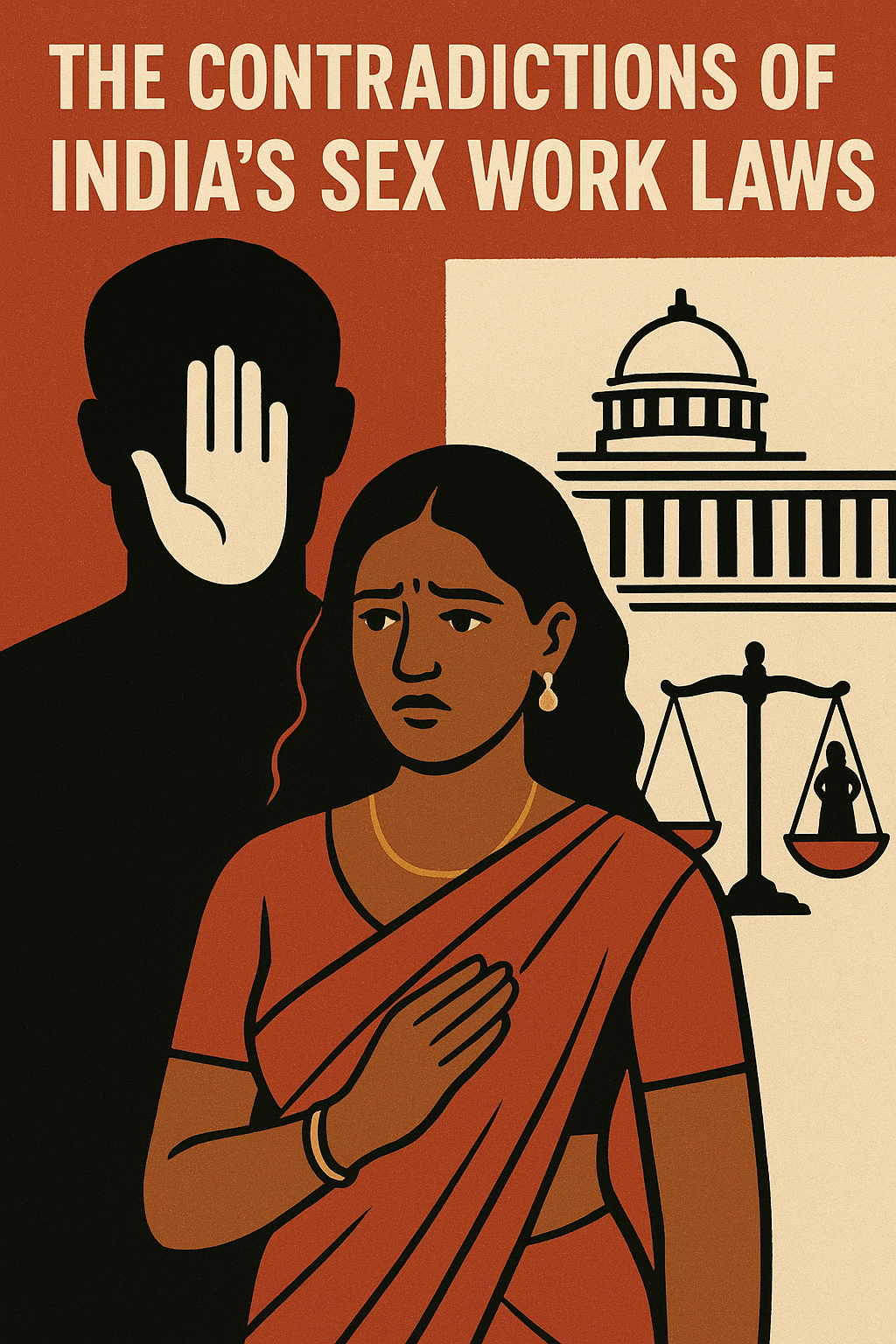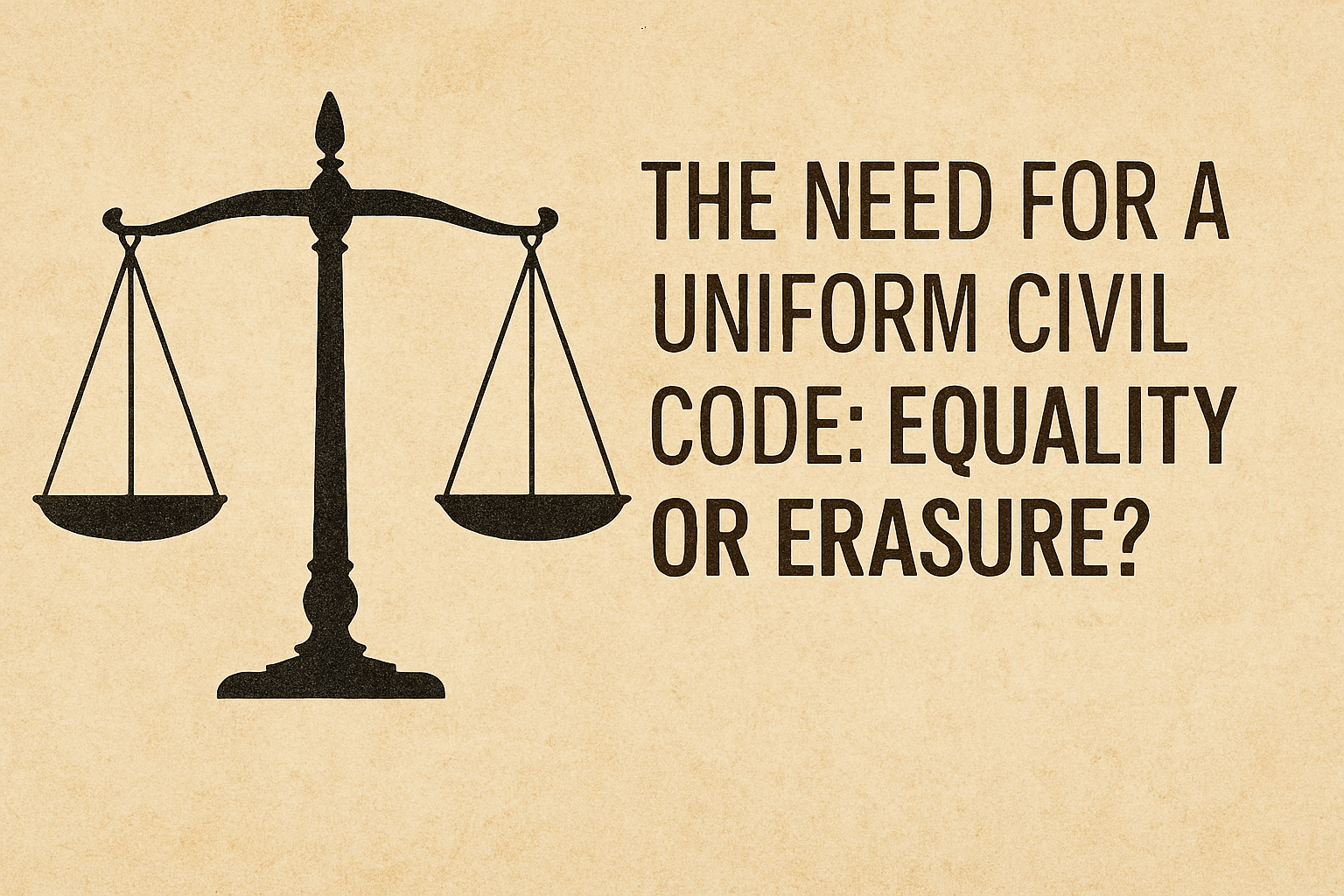



Author-Urwashi Pandey, Deshbandhu College, University of Delhi
One of the most controversial and complex topics in Indian constitutional discourse is the Uniform Civil Code (UCC).At its core, the UCC seeks to establish a single body of civil laws that would apply collectively to all citizens of India, irrespective of their religion, caste, or gender. These laws would govern personal matters such as marriage, divorce, inheritance, adoption, and maintenance areas currently regulated by religion-specific personal laws.
The UCC, which has its roots in Article 44 of the Directive Principles of State Policy, is intended to support the nation’s secular fabric, foster national integration, and guarantee equality before the law. However, its implementation remains contested, caught between the promise of gender equality and a fear of cultural homogenization. While the Constitution guarantees freedom of religion under Articles 25 to 28, Article 44 nudges the State toward replacing religiously governed personal laws with a common civil framework.
The central dilemma that arises is: Can uniformity in personal laws bring about true equality, or does it risk erasing the cultural and religious diversity that India is built on?
Historical Background-
In India, the concept of a Uniform Civil Code (UCC) originated during British colonial rule.The Lex Loci Report of 1840 promoted universal rules for crimes, contracts, and evidence while purposely excluding personal laws like marriage, inheritance, and religious rituals in order to protect India’s religious diversity. As a result, public and criminal law remained consistent, and Hindus, Muslims, Christians, and Parsis were still under the civil laws of their respective religions.
This dual system solidified split personal regulations that differed by caste, geography, and custom within religions and between them. For instance, orthodox Hindu law forbade widow remarriage, but certain lower-caste Hindu societies would allow it. For proper administration, the British frequently ignored regional or progressive customs in favor of Brahminical interpretations.
Sharia law gave Muslim women certain rights, such as inheritance and maintenance, but they were rarely upheld. The Muslim Personal Law (Shariat) Application Act of 1937, which effectively reintroduced Islamic law in personal matters, was prompted by prevalent discriminatory local customs.
Social reformers like Ishwar Chandra Vidyasagar pushed for legislative improvements for Hindu women due to systematic gender injustice. Early reform initiatives were the Hindu Widow Remarriage Act (1856) and the Married Women’s Property Act (1923). Meanwhile, motivated by the 1931 Karachi Congress resolution, which promised equal rights for both men and women, women’s organizations like the All India Women’s Conference started calling for a unified civil code that would ensure equality across communities.
In order to further gender fairness, the B.N. Rau Committee suggested defining the Hindu laws in 1940s. But political prudence meant that only Hindus were the subject of attention. The Constituent Assembly discussed the UCC in great detail after independence. As Law Minister, Dr. B.R. Ambedkar vigorously promoted it, claiming that national cohesion and gender equality depends on a single civil code. However, the idea was not passed into law because of strong resistance, particularly from conservative religious groups.
Instead, the Constitution was amended to include Article 44 of the Directive Principles of State Policy (DPSPs). The State will work to ensure that all Indian citizens have access to a uniform civil code, as stated in Article 44. Since it is a Directive Principle, it remains a constitutional goal rather than a legally binding mandate.
The Hindu Code Bills, which addressed marriage, adoption, guardianship, and succession, brought about significant improvements for Hindus in 1956. Women are granted rights like inheritance and divorce through these legislation. However, other religious communities did not receive the same improvements. Interfaith civil marriages were permitted under secular law by the Special Marriage Act of 1954; however, they were still optional and not required.
How can the Uniform Civil Code benefit us?
At its core, the Uniform Civil Code (UCC) is not a legal reform; it’s a vision of national unity, equality, and progress. By replacing fragmented personal laws with a single civil framework applicable to all citizens, the UCC promises a more cohesive, just, and secular Indian society. While the idea has sparked polarizing debates, its benefits, if implemented with sensitivity and inclusivity, could be far-reaching for the nation.
A major advantage of the UCC is the promotion of gender justice. Many existing personal laws continue to discriminate against women, especially in matters like marriage, divorce, inheritance, and maintenance. For instance, some interpretations of Muslim personal law allow men to practice polygamy or divorce unilaterally through talaq, while offering women few options. Similarly, Hindu daughters were historically denied equal inheritance rights. A uniform code would correct these imbalances by ensuring that all citizens, regardless of religion, are treated equally under the law, upholding the constitutional promise of gender equality and human dignity.
The UCC strengthens India’s secular character. Though the Constitution guarantees religious freedom, the existence of religion-based civil laws often reinforces communal divides. A common civil code would ensure that civil rights and obligations are determined not by religious identity but by universal principles of justice. This would reinforce the idea that in a democracy, the rule of law stands above sectarian factors, making secularism more meaningful in everyday life.
UCC holds the potential to reduce identity-based segregation. In a country as diverse as India, a shared legal framework can foster a great sense of belonging and unity. It could eliminate confusion in cases of interfaith marriage, custody, or succession. Where overlapping and conflicting personal laws often delay justice. Simplifying the legal system could reduce the burden on Indian courts and make laws more accessible and understandable for the ordinary citizens. In many cases, people, especially women, LGBTQ+ individuals, and those from marginalized castes, face pressure to conform to regressive practices in the name of tradition. A UCC would prioritize individual freedoms over group customs, ensuring that no one’s rights are compromised due to patriarchal or discriminatory norms.
Finally, the implementation of a UCC could depoliticize religion in civil matters. When laws vary based on faith, they often become tools for political mobilization. The existence of multiple personal laws allows parties to target a specific vote bank under the pretext of religious protection. A uniform code could shift the focus from identity-based politics to constitutional values like justice, equality, and human dignity, strengthening democracy in the long run.
Concerns and Challenges in the Implementation of the Uniform Civil Code—
Despite its ideals, the Uniform Civil Code faces several complex legal, cultural, and political challenges that demand careful consideration. Many communities, especially minorities, fear that a uniform code may become a tool for cultural homogenization rather than empowerment. These concerns are rooted in a deeply diverse society where religious and cultural identities have been central to personal and community life.
One of the most pressing fears is of cultures being erased. Minority groups fear that the UCC could impose majoritarian norms and diminish their distinct traditions. In a country such as India, customs vary not only between but also within religious communities; enforcing a single legal code could overlook and even erase local practices that hold deep meaning for people. Rather than promoting unity, such an approach may further deepen divisions if not handled carefully.
In today’s politically charged climate, discussions around the UCC are often accompanied by rhetoric that targets specific communities, particularly Muslims. This has led to fear that the code may be implemented selectively, serving political agendas rather than justice. For many, the issue is not whether civil equality is desirable, but whether the state can be trusted to enforce it without bias or coercion.
Implementing a UCC involves tremendous legal and logistical complexity. Local traditions, sub-caste identities, and regional customs are all entwined with India’s laws. Creating a common code that respects this diversity while ensuring equality is a challenging task. Moreover, distinguishing between discriminatory practices and culturally significant customs is subjective and often controversial, raising further complications. Articles 25 to 28 of the Indian Constitution guarantee the right to freely practice and propagate religion, while Article 44, part of the Directive Principles, encourages the adoption of a uniform civil code. Critics argue that imposing civil uniformity could interfere with religious freedom. Balancing these two constitutional ideals, equality and freedom of belief, requires nuanced, democratic engagement rather than legal imposition.
Many social reforms in the past, especially those involving women’s rights, have met opposition from religious leaders and from within families and local communities. Changing deeply embedded social norms takes time, dialogue, and consistent advocacy. A sudden, top-down enforcement of the UCC could provoke backlash.
Conclusion-
The Uniform Civil Code has profound cultural, emotional, and historical roots, making it more than just a legal matter. The recent deployment in Uttarakhand raises questions about inclusivity and a lack of public discourse, but it also provides a taste of its potential. One thing is certain, even though there may not be a perfect solution just yet: we must never sacrifice the equality, religious freedom, and human dignity that the Constitution guarantees while we work toward reform.
India’s real strength is in striking a balance between fairness and variety, not in imposing conformity. Fairness for everyone should be the aim.
Bibliography-
Uniform Civil Code in India- https://www.crpc.in/images/uniform-civil-code.pdf#:~:text=Uniform%20civil%20code%20in%20India%20is%20the,each%20major%20religious%20with%20a%20common%20set.
UCC PART-1 – Constitutional – History-
https://clpr.org.in/wp-content/uploads/2017/11/UCC-Part-1-Constitutional-History.pdf
Unraveling the Uniform Civil Code (UCC): Evolution, implications, and challenges in contemporary India –
https://www.criminallawjournal.org/article/67/4-1-13-452.pdf
NCW 13 SEP 2023-
https://www.nluassam.ac.in/docs/events/NCW%2013%20SEP%202023.pdf
India, Uttarakhan,d becomethe s first state to implement the Uniform Civil Code-
https://www.jurist.org/news/2025/01/india-uttarakhand-becomes-first-state-to-implement-the-uniform-civil-code/#:~:text=Uttarakhand%20became%20the%20first%20Indian,milestone%20in%20India’s%20legal%20landscape.
Uniform Civil Code in modern India: Historical roots, contemporary developments, and the role of the judiciary in pursuit of ‘One Nation-One Law’-
https://www.lawjournal.info/article/90/4-1-8-824.pdf